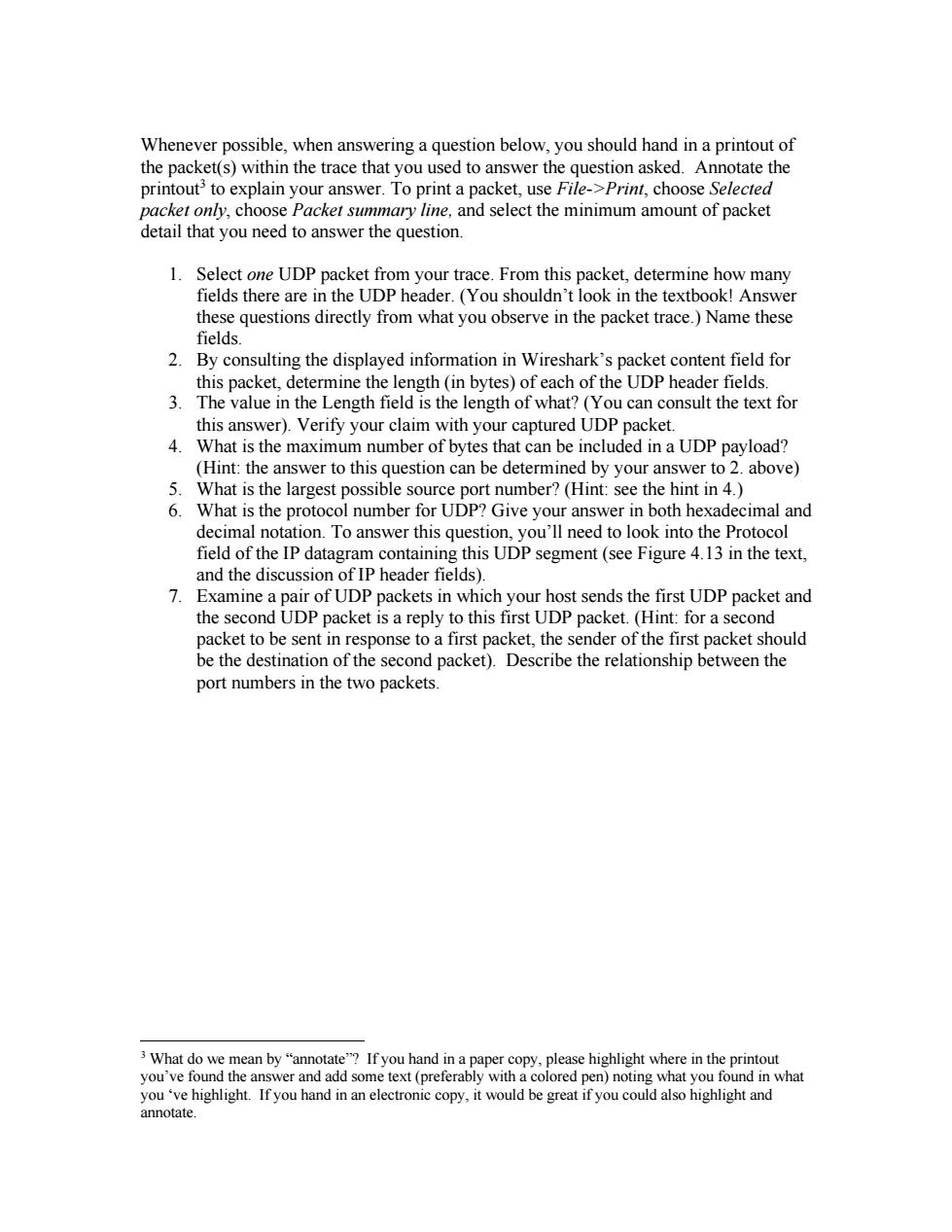正在加载图片...

Whenever possible,when answering a question below,you should hand in a printout of the packet(s)within the trace that you used to answer the question asked.Annotate the printout to explain your answer.To print a packet,use File->Print,choose Selected packet only,choose Packet summary line.and select the minimum amount of packet detail that you need to answer the question 1. Select one UDP packet from your trace.From this packet,determine how many fields ther the udp (You sl uldn't look in the textbook!An uestions di ectly from what you in the pa ke trace.)Name these ields 2. By consulting the displayed info rmation in Wireshark's ket con ent field for ength (in bytes)of each o th UDP hea fields 3. ne ength fi is the length of what ou can consult the text for this answer).Verify your claim with your captured UDP packet. What is the maximum number of bytes that can be included in a UDP payload? (Hint:the answer to this question can be determined by your answer to 2.above) 5. What is the largest possible source port number?(Hint:see the hint in 4.) 6.What is the protocol number for UDP?Give your answer in both hexadecimal and decimal notation.To answer this question,you'll need to look into the Protocol field of the IP datagram containing this UDP segment(see Figure 4.13 in the text, and the discussion of ip header fields) 7.Examine a pair of UDP packets in which your host sends the first UDP packet and the second UDP packet is a reply to this first UDP packet.(Hint:for a second packet to be sent in response to a first packet,the s nder of the first packet should be the destination of the second packet).Describe the relationship between the port numbers in the two packets 3 What do we an by"an e highlight where in the you've found the ans you've highlight.If you hand in an electronic copy,it would be great if you could also highlight andWhenever possible, when answering a question below, you should hand in a printout of the packet(s) within the trace that you used to answer the question asked. Annotate the printout3 to explain your answer. To print a packet, use File->Print, choose Selected packet only, choose Packet summary line, and select the minimum amount of packet detail that you need to answer the question. 1. Select one UDP packet from your trace. From this packet, determine how many fields there are in the UDP header. (You shouldn’t look in the textbook! Answer these questions directly from what you observe in the packet trace.) Name these fields. 2. By consulting the displayed information in Wireshark’s packet content field for this packet, determine the length (in bytes) of each of the UDP header fields. 3. The value in the Length field is the length of what? (You can consult the text for this answer). Verify your claim with your captured UDP packet. 4. What is the maximum number of bytes that can be included in a UDP payload? (Hint: the answer to this question can be determined by your answer to 2. above) 5. What is the largest possible source port number? (Hint: see the hint in 4.) 6. What is the protocol number for UDP? Give your answer in both hexadecimal and decimal notation. To answer this question, you’ll need to look into the Protocol field of the IP datagram containing this UDP segment (see Figure 4.13 in the text, and the discussion of IP header fields). 7. Examine a pair of UDP packets in which your host sends the first UDP packet and the second UDP packet is a reply to this first UDP packet. (Hint: for a second packet to be sent in response to a first packet, the sender of the first packet should be the destination of the second packet). Describe the relationship between the port numbers in the two packets. 3 What do we mean by “annotate”? If you hand in a paper copy, please highlight where in the printout you’ve found the answer and add some text (preferably with a colored pen) noting what you found in what you ‘ve highlight. If you hand in an electronic copy, it would be great if you could also highlight and annotate